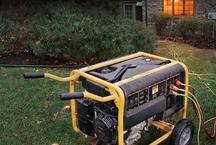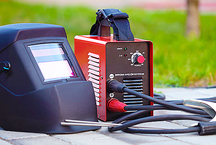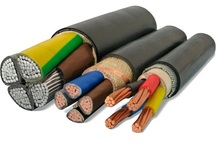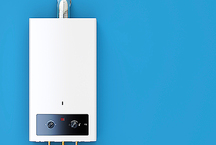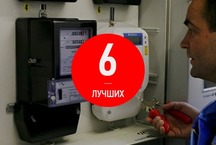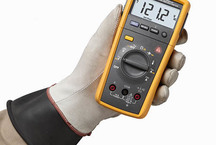Top 10 voltage regulators


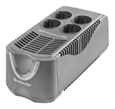


Standards provide for the maximum deviation of voltage in the network at a level of not more than 10%. Unfortunately, very often, especially in the private sector, where the substations were designed for much lower power consumption, voltage drops reach values several times higher, and when you turn off a powerful load, equally powerful surges occur. Such instability can have many unpleasant consequences: if blown-out lamps are even the lesser of evils, then failures in the operation of control electronics or the failure of home appliances will unwittingly make you think about buying a voltage stabilizer.
In today's ranking, we will look at the best. single phase household stabilizers, the most popular on the market and deserving positive feedback from customers: from low-power models, the task of which is to protect your computer or TV, to serious devices designed to be installed directly on the input of electricity to a private house or apartment.
| Category | A place | Name | Rating | Price |
|---|---|---|---|---|
| The best voltage regulators for one or two devices (up to 1 kW) | 1 | RESANTA ACH-1000/1-EM | 9.5 / 10 | 3 850 |
| 2 | SVEN AVR 500 | 9.0 / 10 | 3 850 | |
| 3 | Powercom TCA-1200 | 8.4 / 10 | 1 450 | |
| 4 | Defender AVR Premium 600i | 8.2 / 10 | 1 450 | |
| The best high-precision stabilizers for gas boilers | 1 | PROGRESS 8000SL | 10 / 10 | 60 800 |
| The best voltage regulators for connecting multiple devices | 1 | Energy Classic 9000 | 9.8 / 10 | 31 700 |
| 2 | RUCELF SRW-10000-D | 9.7 / 10 | 11 283 | |
| 3 | PROGRESS 12000T-20 | 9.0 / 10 | 38 200 | |
| The best voltage regulators for installation on input | 1 | Energy Classic 20000 | 9.8 / 10 | 66 400 |
| 2 | Volter СНПТО-22 Ш | 9.5 / 10 | 92 230 |
The best voltage regulators for one or two devices (up to 1 kW)
|
3 850
Although Chinese-made equipment sold in Russia under the “Resanta” brand has earned quite controversial reviews (first of all welding inverters), in this case one can speak of clear success: in terms of price and characteristics, the voltage regulator ASN-1000 deserved a worthy place in the ranking of the best.
Although it is made according to the classic relay circuit (it’s problematic to keep the cost of the electronic stabilizer), the developers managed to enable it to work in a wide input voltage range: from 140 to 260 V. At the same time, the used autotransformer has a sufficient number of sections to provide small oscillations output voltage (recall that the main problem of the relay stabilizers is a step change in the output voltage - when the input voltage changes, the control electronics perekommutiruet about autotransformer windings and, the more of them, the less coarse adjustment). The accuracy declared by the manufacturer (216 ... 224 V) is confirmed in practice, and the response time of 10 ms is at the level of the best modern relay voltage regulators. The maximum power of 1 kW will be enough even for a gaming computer that turns the lion's share of electricity consumed into heat. The stabilizer itself has a very high efficiency (97%), so that even at high loads it overheats only when working on the verge of shutdown (the mains voltage is less than 150 V). But due to the fact that the manufacturer did not save on protection against overheating and overload, the stabilizer will not only inform in advance about the output in the critical mode of operation, but also turn off in time. Main advantages:
Minuses:
|
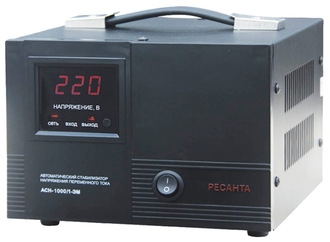 9.5 / 10
Rating
Reviews
When I saw on the display how the voltage jumps in my outlet, I regretted that I had not bought a stabilizer for the computer before. Moreover, it is quite inexpensive. |
|
3 850
If the weighty box “Resantsy” requires a fair amount of space under the table, then the SVEN compact voltage stabilizer can easily fit anywhere, especially since its plastic case is quite aesthetic - the arrow gauges on the front panel give it a certain zest. The maximum power of this model is 400 W (the five hundred indicated in the marking is not watts, but volt-amperes; we already wrote about the difference between active and total power in the article about petrol generators), and it is quite enough for a working computer of average configuration, a TV or music center.
The characteristics of the AVR 500 even exceed in some respects the “Resants” parameters - this stabilizer has the widest working range (100-280 V), but because of this the stabilization accuracy (202-238 V) is coarser. The reaction rate here is up-to-date: few relay stabilizers manage to achieve an indicator of less than 10 ms. So, if you need a compact stabilizer, SVEN AVR 500 is quite worthy of the best recommendations. Main advantages:
Minuses:
|
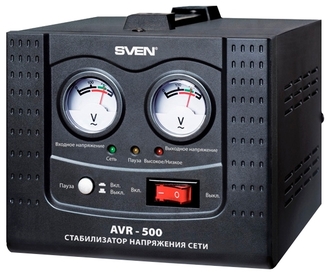 9.0 / 10
Rating
Reviews
It is easy to find a place to install, the relay clicks are not strong enough to start annoying. I think a good stabilizer. |
|
1 450
An extremely inexpensive device would be quite appropriate in your apartment if the voltage drops are small, but jumps are common: for the minimum operating voltage (176 V), the Powercom noticeably lost to the leaders of the rating, but its maximum is quite good - 264 V. The stabilizer is extremely compact, but it supports up to 600 watts in total on all four outlets. They are just enough to connect the system unit, monitor and inkjet printer (we do not recommend including a powerful laser printer: they have high inrush currents at the beginning of the operating cycle).
The accuracy of stabilization here is 9% (alas, the compact dimensions demanded a reduction in the number of power relays and a noticeable deadening of accuracy). However, the standard stabilizer fits confidently, although close to the limit. On the other hand, its price is one of the lowest in the market, so if you don’t suffer from excessive perfectionism or don’t plan to connect highly sensitive electronics, Powercom is not the worst choice. Main advantages:
Minuses:
|
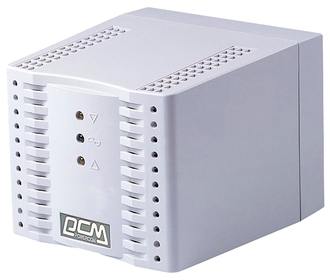 8.4 / 10
Rating
|
|
At first glance, this stabilizer has good chances for high ranking positions of the best: a compact floor version, four grounded sockets, a completely aesthetic appearance and an affordable price. But the total score had to be significantly reduced ... However, about everything in order.
So, open the list of technical specifications. The operating voltage range of 150-280 V allows the AVR-1600 to work in the very harsh conditions of dacha operation without major problems: even if your left neighbor turns on the circular and the second starts to boil the fence, the voltage drops at the substation that remembers the young Brezhnev will not to worry We mentioned welding for good reason: the built-in surge protector here is quite effective for a budget stabilizer that suppresses impulse noise. But the stabilization accuracy of the Defender AVR Premium 600i, alas, got into GOST as a late passenger on the train: “clinging to the footboard” - the output voltage can vary from 198 to 242 V (the settings are clearly designed for the European standard, but on the other hand , and most household appliances, too).Let us subtract from the rating and points for power - still 250 W is not so much, although the figure “600” stands in the model marking. Main advantages:
Minuses:
|
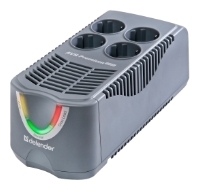 8.2 / 10
Rating
Reviews
At the dacha there was no point in buying a powerful or expensive stabilizer - and this one confidently pulls out even with strong drawdowns (we also have 170 V instead of 220 in the outlet). |
The best high-precision stabilizers for gas boilers
|
60 800
Taking into account the rated power of 6.4 kW, the purchase of this stabilizer will allow you not only to reliably protect the gas boiler from power surges, but also to additionally power a number of sockets in the house. The 8000SL stabilizer, performed on a modern electronic base, has excellent characteristics: its operating range allows you to maintain normal voltage with drawdowns up to 125 V and jumps up to 270 V, and the stabilization accuracy of all models offered by the market can be recognized as one of the highest: 0.9%. At the same time, delays and pulsations are minimal - this is the unquestionable merit of the triac cascade of voltage regulation.
Thanks to forced cooling, the stabilizer is reliably protected from overheating. However, even dusty radiators will not cause damage - the protective circuits here are accurate and reliable. When installed in an apartment, you will appreciate its noiselessness: instead of clicking a relay, a working stabilizer emits only a slight rustle with its fans. Main advantages:
Minuses:
|
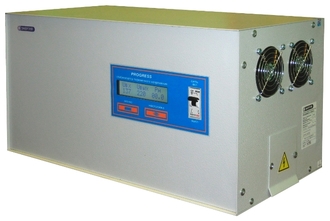 10 / 10
Rating
Reviews
The best stabilizer, I think - I managed to “hang” almost everything on one stabilizer - both the electronics and the boiler, which until then was constantly blocked due to power surges. |
The best voltage regulators for connecting multiple devices
|
31 700
Wall stabilizer with a maximum power of 6.3 kW can safely claim to be the best model for a private house. Judge for yourself: thanks to the use of electronic stabilization, it is practically silent, and its operating range starts from 125V. Such a magnitude of the voltage drawdown is rarely reached, so that it will not have to work at the limit of opportunities.
The combination of a relay primary cascade with a terminal electronic stabilizer in the Classic 9000 model demonstrated all its advantages: the manufacturer, using a 12-stage relay unit, provided the stabilizer with a wide operating range, while the thyristor cascade maintains stabilization accuracy at 5% - an excellent result for small for this equipment class money. Of course, the response time (20 ms) here at the level of modern models does not look the best, but on the other hand, the voltage “steps” affecting the autotransformer windings much more affect the operation of the connected equipment than the switching time. Add to the list of advantages Classic 9000 and high reliability: even when working in a damp cold room, it will not be reminded of its existence by failures. Main advantages:
Minuses:
|
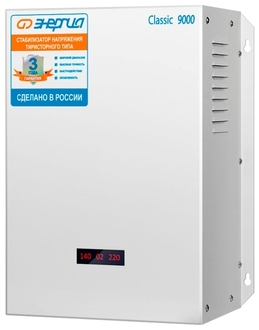 9.8 / 10
Rating
Reviews
Stabilizer from the “set and forget” series - and I always appreciated this in technology. |
|
11 283
In terms of its ability to "digest" voltage drops, the 7-kilowatt Rucelf is one of the best relay stabilizers: its minimum operating threshold is 137 V. Jumps up to 270 V will also be processed without any problems.For stabilizers of similar power, finding a place to install causes certain difficulties: their dimensions become solid, and ordinary floor-type “box” models can be inconvenient. It also provides for mounting on the wall: the stabilizer can be fixed at the entrance of the power supply and not stumble about it at the entrance to the house.
Indeed, taking into account its power, operating range and especially the price, the SRW-10000-D stabilizer will be the best choice for summer residents: it is not so easy to load it by 7 kilowatts at the dacha, but you definitely appreciate the performance with strong voltage surges. I am glad that at such a price, the manufacturer managed to ensure quite decent stabilization accuracy of 6% - so, in terms of the total set of qualities, the best recommendations can be considered well-deserved. Main advantages:
Minuses:
|
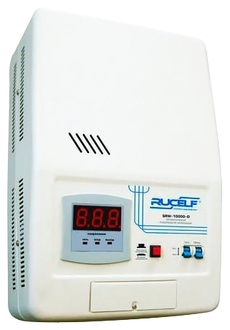 9.7 / 10
Rating
Reviews
At the dacha, he has been helping me out for more than a year - the substation has long been asking for a replacement, so who would have done ... |
|
38 200
If in our ranking of the best voltage regulators with a power of up to 10 kW in the subcategory “most accurate” and “most powerful”, Progress 12000T-20 would become the leader in them. Its rated power is 9.6 kW, so by installing it in your home, you will power all consumers that are sensitive to voltage drops. Considering that he uses electronic stabilization with an accuracy of 2.5%, he will be able to work with a number of gas boilers, although more capricious ones may require more expensive 8000ST. The presence of all necessary protections, effective ventilation also add their advantages to his piggy bank.
However, the leadership in terms of the characteristics of this model was not achieved: in practice, it lost to the “Energy Classic 9000”, which is also somewhat cheaper, and three times more affordable Rucelf in the working range: if the voltage drops below 180 V, they do not interfere, for Progress 12000T-20 they are already critical. Therefore, before choosing a suitable model, clearly determine the average voltage fluctuations in the outlet: perhaps a less accurate stabilizer with a wide operating range will be more relevant in your case. Main advantages:
Minuses:
|
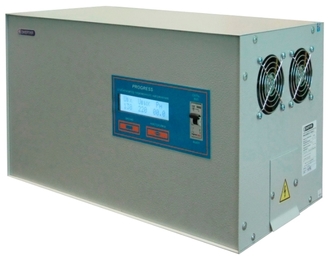 9.0 / 10
Rating
Reviews
In the cottage, this stabilizer with confidence "feeds" half of the outlets. The boiler, however, did not try to connect - he is on his bespereboynik. |
The best voltage regulators for installation on input
|
66 400
The power of 14 kW is enough not only for a private house, but also for a small workshop: you can safely install it on the inlet, since the construction designed for wall mounting will make it possible to conveniently place the stabilizer next to the electrical panel (when mounting do not forget about a solid mass of 42 kg - without anchors can not do here). With technical characteristics, as with all Energy stabilizers, the Classic 20000 is fine: the operating range covers 125 to 254 V, so you can safely forget about voltage sags, the accuracy of stabilizing the output voltage doubles the requirements of GOST (five%).
I am glad that a high-quality and quite affordable stabilizer is a Russian product: in its reliability, it can compete on equal terms with much more expensive competitors, and in the aggregate of qualities it definitely surpasses them. A warranty of 3 years is also a considerable argument when choosing this particular model (the full resource, according to the manufacturer, is at least 15 years). Main advantages:
Minuses:
|
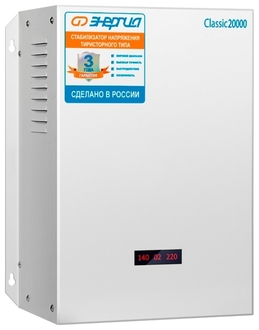 9.8 / 10
Rating
Reviews
Once and for all forget about power surges - it costs a lot! And if the stabilizer also works for years without interruptions, then its price is all the more justified. |
|
92 230
The most powerful stabilizer in our rating is a guest from Ukraine. You can connect a load up to 22 kW to this model, so that feeding all consumers in the house completely from a stabilizer will not be a problem. The Volter design allows for quick adjustment of the output voltage level, which is easily monitored on the front panel LCD screen.
As well as in the stabilizers of the “Energy Classic” family, a combined circuit is used here: at the input there is a seven-step relay unit connected to the output through an electronic stabilization circuit. The operating range of the stabilizer is from 130 to 270 V, and this is a very good indicator. But with the accuracy of the device, alas, disappoint: the output voltage can vary in the range from -10% to + 7%, so that it fit into the GOST "with a scratch." To a certain extent, this is compensated for by the possibility of installing outside heated premises: the manufacturer claims that the stabilizer can operate at a negative temperature down to -40˚ C. Main advantages:
Minuses:
|
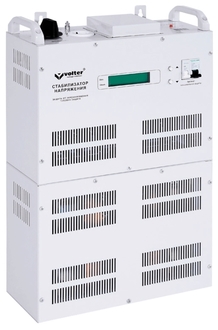 9.5 / 10
Rating
Reviews
The most accessible of the powerful stabilizers, of course, inspired some doubts due to the origin, but in practice they have not been confirmed - since the commissioning, neither repair nor adjustment is required. |
What you need to know about voltage regulators when choosing?
- Type of The stabilizer directly determines its characteristics. If a relay stabilizerswhose job is to switch a set of autotransformer windings when the voltage is out of the specified range, are cheap, but noisy and not accurate enough, electronic stabilizers they are devoid of these shortcomings and have greater speed - but their price is much higher. Combined schemes in most cases will be the “golden mean” in terms of price / quality ratio. Stand alone electromechanical stabilizers - their output voltage is removed from the contact moved by the servo drive along the winding of the autotransformer. On the one hand, it gives a wide operating range and high accuracy, on the other - they have too high reaction times and low reliability.
- The number of phases. Manufacturers offer single and three phase devices. It is necessary to give preference to the second option in the case when there is at least one 3-phase consumer in the home or office.
- Working rangeThe stabilizer determines the maximum and minimum voltage values at which it is capable of supporting a given output voltage. However, take into account the real voltage drop in your network when choosing a relay stabilizer - with the same number of steps, the stabilizer with a narrower range will be more accurate, and you may not need the ability to work with extreme drawdowns.
- Housing designIt should be chosen in accordance with the operating conditions: the wall stabilizer is more convenient than the floor stabilizer, but its installation is more labor intensive, and powerful and heavy stabilizers should not be fixed to the wooden walls: prefer the floor stabilizer.
In our rating, we chose 10 models that are common for sale and that can best meet various requirements: whether you need a compact stabilizer for a computer or a powerful device that can protect the whole house - you can find a suitable model in our review.
